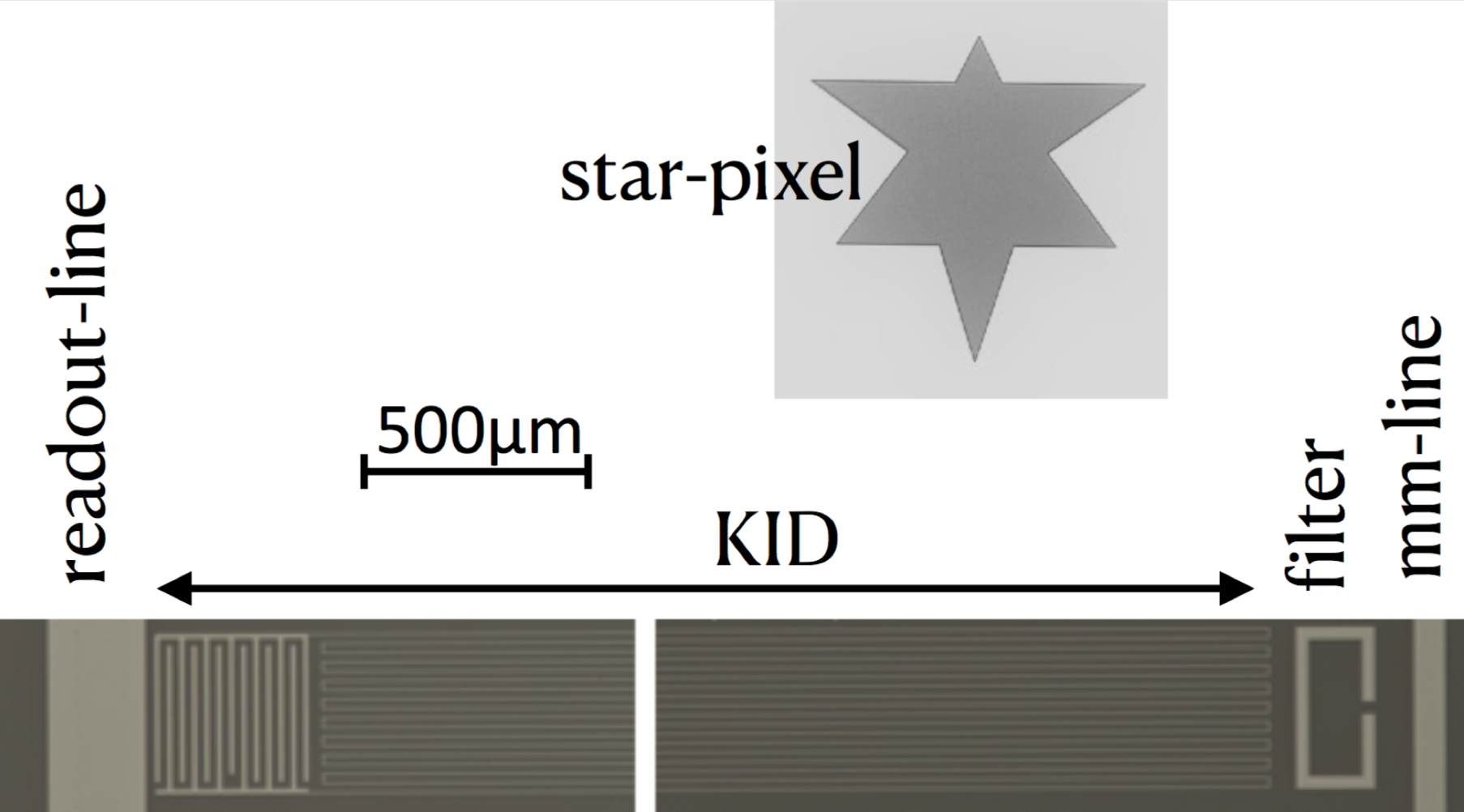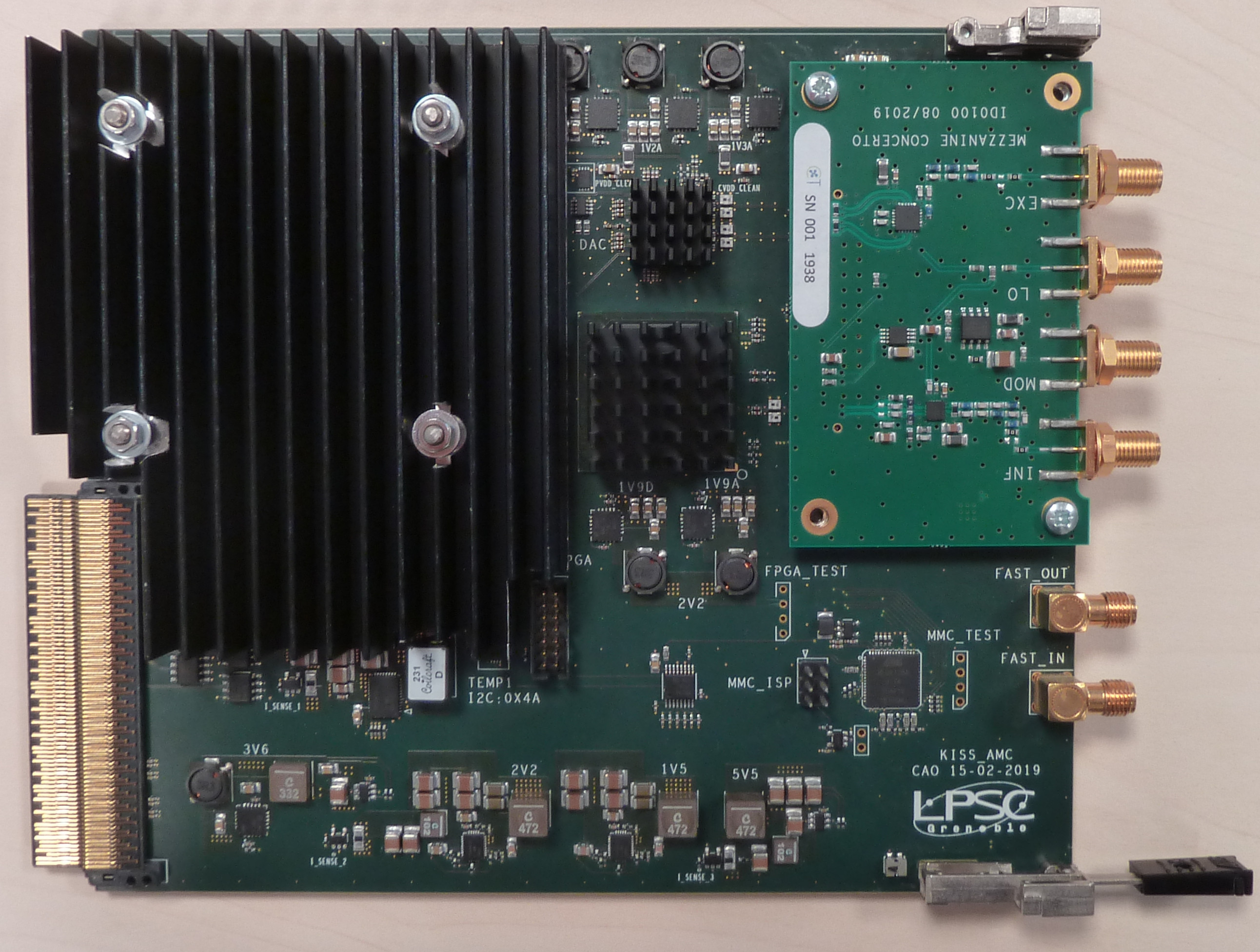![]()
![]()
![]()
![]()
![]()
![]()
![]()
 KID arrays. One of the fundamental assets of KIDs is that they can
be easily multiplexed, reading out hundreds of pixels with a single
feedline. While this is true on paper, actually achieving large format
arrays, with thousands of good working pixels, remains a challenging
task. The GIS collaboration has been working in this direction
constantly over more than a decade, passing from the tens or hundreds
of pixels per array of the NIKA camera, to ~1000 pixels per array in
NIKA2 and ~2000 in CONCERTO. This has been possible thanks to the
experience gained developing such cameras, coupled to the effort done
to get an always better understanding of the key aspects that play a
role in the final quality of an array. These include in particular
mastering the various fabrication steps that are needed to produce an
array, simulating the devices and choosing the designs that can
accommodate the largest number of pixels while minimizing the risks of
frequency collisions, and optimizing the architecture of the focal
plane, to assure an efficient optical coupling, the good
thermalization of the arrays and a solid mounting. Today, we are
working on the next generation of large format arrays, called 8KID:
one single 4 inches wafer containing more than 8000 pixels, optimized
for the mm-wave bands. We have already fabricated and tested the first
working samples. Being able to consistently produce high quality 8KID
arrays will be a crucial step towards the next generation of
experiments, with focal planes requiring tens of thousands of
detectors.
KID arrays. One of the fundamental assets of KIDs is that they can
be easily multiplexed, reading out hundreds of pixels with a single
feedline. While this is true on paper, actually achieving large format
arrays, with thousands of good working pixels, remains a challenging
task. The GIS collaboration has been working in this direction
constantly over more than a decade, passing from the tens or hundreds
of pixels per array of the NIKA camera, to ~1000 pixels per array in
NIKA2 and ~2000 in CONCERTO. This has been possible thanks to the
experience gained developing such cameras, coupled to the effort done
to get an always better understanding of the key aspects that play a
role in the final quality of an array. These include in particular
mastering the various fabrication steps that are needed to produce an
array, simulating the devices and choosing the designs that can
accommodate the largest number of pixels while minimizing the risks of
frequency collisions, and optimizing the architecture of the focal
plane, to assure an efficient optical coupling, the good
thermalization of the arrays and a solid mounting. Today, we are
working on the next generation of large format arrays, called 8KID:
one single 4 inches wafer containing more than 8000 pixels, optimized
for the mm-wave bands. We have already fabricated and tested the first
working samples. Being able to consistently produce high quality 8KID
arrays will be a crucial step towards the next generation of
experiments, with focal planes requiring tens of thousands of
detectors.
 Silicon lenses.
In the recent years our collaboration acquired a lot of experience in the design
and fabrication of plastic lenses (High Density Polyethylene and
Polypropylene) currently used in instruments such as NIKA2, KISS and
CONCERTO. However, for the next generation instruments we need to develop higher
Field-of-View and consequently larger lenses up to a diameter of the
order of 300-400 mm. For such large optical elements, plastic is no
longer a suitable material because of its low refractive index. On the
contrary, silicon is an excellent choice due to its low loss at
millimeter and sub-millimeter wavelengths and to its high index of
refraction leading to high-throughput and large field of view optical
designs ideal for a large sky survey. However the high index of
refraction of the silicon lenses also means that a significant
fraction of the incident light is reflected. This not only causes less
light to reach the detectors, causing a decrease in the overall
sensitivity, but it can also lead to other instrument systematics due
to multiple reflections occurring in the instrument. The undesirable
consequences of the high index means that the lenses must have
Anti-Reflection (AR) coatings in order to deliver state-of-the-art
measurements of the sky. To solve this problem we develop
meta-material AR coatings. Metamaterial AR coating consists of
sub-wavelength features machined with a milling machine into an
optical surface which act as effective dielectric layers. The shape
and dimensions of the sub-wavelength features of the metamaterial
coating can be tuned to result in sub-percent reflections across the
identified bandwidth. This R&D work is possible through the use of a specific milling machining which
is provided thanks to a LABEX ENIGMASS funding. The first prototypes
of Silicon lenses are supposed to be produced in 2023.
Silicon lenses.
In the recent years our collaboration acquired a lot of experience in the design
and fabrication of plastic lenses (High Density Polyethylene and
Polypropylene) currently used in instruments such as NIKA2, KISS and
CONCERTO. However, for the next generation instruments we need to develop higher
Field-of-View and consequently larger lenses up to a diameter of the
order of 300-400 mm. For such large optical elements, plastic is no
longer a suitable material because of its low refractive index. On the
contrary, silicon is an excellent choice due to its low loss at
millimeter and sub-millimeter wavelengths and to its high index of
refraction leading to high-throughput and large field of view optical
designs ideal for a large sky survey. However the high index of
refraction of the silicon lenses also means that a significant
fraction of the incident light is reflected. This not only causes less
light to reach the detectors, causing a decrease in the overall
sensitivity, but it can also lead to other instrument systematics due
to multiple reflections occurring in the instrument. The undesirable
consequences of the high index means that the lenses must have
Anti-Reflection (AR) coatings in order to deliver state-of-the-art
measurements of the sky. To solve this problem we develop
meta-material AR coatings. Metamaterial AR coating consists of
sub-wavelength features machined with a milling machine into an
optical surface which act as effective dielectric layers. The shape
and dimensions of the sub-wavelength features of the metamaterial
coating can be tuned to result in sub-percent reflections across the
identified bandwidth. This R&D work is possible through the use of a specific milling machining which
is provided thanks to a LABEX ENIGMASS funding. The first prototypes
of Silicon lenses are supposed to be produced in 2023.
 On-chip spectroscopy. The development of KID
based spectroscopy aims to provide different technological options to
study millimeter waves at different energy resolutions
R=Δν/ν ranging from 10 to 10,000. Among other
astrophysical challenges, two are of greater importance to us. The
first is to separate the so called B modes of the Cosmic Microwave
Background polarization from those of the foreground emission of
galactic dust and synchrotron. The second is to map the intensity
fluctuations of the Carbon II line in early galaxies to understand
better galaxy evolution and star formation at the epoch of
reionization. For low resolution (R~10), we have already coupled KIDs
to a Martin-Puplett interferometer on KISS
and CONCERTO. We are
investigating another solution based KID arrays on wedge-shaped
substrates acting as Fabry-Perot cavity. For R~100, we are
investigating on-chip spectroscopy with superconducting resonant
filters. For even higher resolutions R of 1000 to 10,000, sub-gap
modes of KID made out of particular superconducting materials are
explored as a technological option.
On-chip spectroscopy. The development of KID
based spectroscopy aims to provide different technological options to
study millimeter waves at different energy resolutions
R=Δν/ν ranging from 10 to 10,000. Among other
astrophysical challenges, two are of greater importance to us. The
first is to separate the so called B modes of the Cosmic Microwave
Background polarization from those of the foreground emission of
galactic dust and synchrotron. The second is to map the intensity
fluctuations of the Carbon II line in early galaxies to understand
better galaxy evolution and star formation at the epoch of
reionization. For low resolution (R~10), we have already coupled KIDs
to a Martin-Puplett interferometer on KISS
and CONCERTO. We are
investigating another solution based KID arrays on wedge-shaped
substrates acting as Fabry-Perot cavity. For R~100, we are
investigating on-chip spectroscopy with superconducting resonant
filters. For even higher resolutions R of 1000 to 10,000, sub-gap
modes of KID made out of particular superconducting materials are
explored as a technological option.
 Readout electronics. The readout
electronics, designed to be hosted in rugged micro-TCA
crates, can probe up to 400 KID per readout card over a
large bandwidth (950 MHz). A microTCA can host up to 12 of
these boards and each board uses less than 40W. Each
readout board heavily relies on the use of a Field
Programmable Gate Array (FPGA) and fast digital to analog
and digital to analog converters (2 Gigasamples per
second). The radiofrequency front-end is in charge of
performing the up and down conversion of the signal
between the converters and the cryostat (back and
forth). This electronics is used for radioastronomy and
in-house developments. The firmware of the FPGA can be
adapted to photometry or spectroscopy observations.
Readout electronics. The readout
electronics, designed to be hosted in rugged micro-TCA
crates, can probe up to 400 KID per readout card over a
large bandwidth (950 MHz). A microTCA can host up to 12 of
these boards and each board uses less than 40W. Each
readout board heavily relies on the use of a Field
Programmable Gate Array (FPGA) and fast digital to analog
and digital to analog converters (2 Gigasamples per
second). The radiofrequency front-end is in charge of
performing the up and down conversion of the signal
between the converters and the cryostat (back and
forth). This electronics is used for radioastronomy and
in-house developments. The firmware of the FPGA can be
adapted to photometry or spectroscopy observations.